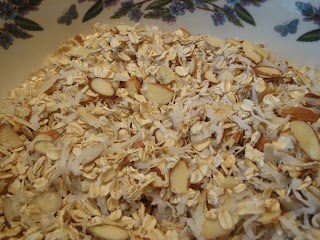It’s the same with fudge. It’s always grainy or lumpy or something just isn’t quite right. It’s a lot easier to visit the local candy shop, Laughing Moon Chocolates in Stowe. (although I’ve been experimenting with chocolate truffles and I prefer my own!)
This is not true for everything, however, and granola is certainly one of the exceptions. I’ve tried a range of granola from grocery stores and gourmet food shops, and it’s all the same. It’s hard and dry with hints of a cardboard or plastic aftertaste. And if it is slightly edible, it's thanks to all the added sugar and chemicals whose names I can't pronounce. Yuck! Isn't granola supposed to be healthy?
The only reason people put up with bad tasting granola is that many think granola is hard to make. Honestly, it couldn’t be simpler to bake, it tastes amazing, and it remains fresh for a long time.
I sold this granola at farmers’ markets this summer, and it was a very popular item. I’m currently shipping bags to customers in Massachusetts.
And now, you can make it for yourself!
Ingredients:
4 cups rolled oats
2 cups slivered almonds
2 cups sweetened shredded coconut
¾ cup vegetable oil
½ cup good-quality honey
1 cup dried apricots, diced
1 cup dried figs, diced
1 cup dried cranberries
1 cup unsalted cashews
1. Preheat the oven to 350 degrees F and line baking sheet with parchment paper.
2. Combine oats, almonds and coconut in a large bowl.

2. Wisk oil and honey together in another bowl then add to oat mixture.


3. Spread mixture evenly onto prepared baking sheet.


4. Bake for 40-45minutes, stirring every 15 minutes.

5. Cool then add dried fruit and cashews.

6. Enjoy!

Next entry...individual fruit tarts...yum yum!



